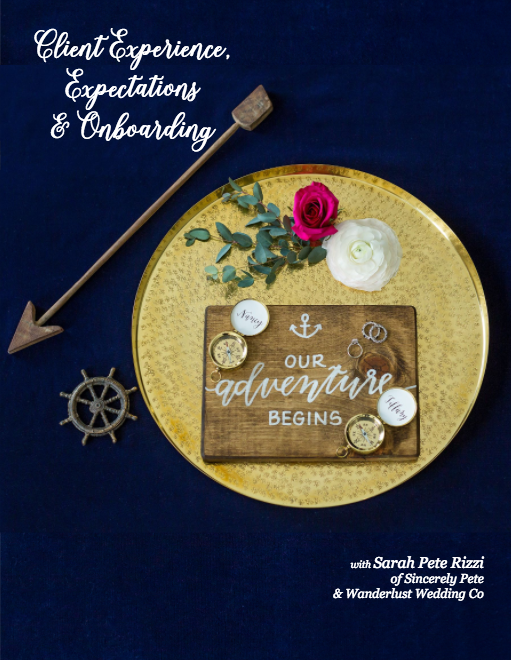
A wise person once said, “It’s easy to forget what people say but nearly impossible to forget how they make you feel.”
Overall, your client experience can look however you decide but ultimately it is a reflection of how you want to be perceived and how you treat others. It covers everything from how you talk to your client, educate them during the planning process and how you respond to their needs, to how you handle difficult situations and interact with other vendors.
Having an above average client experience allows leverage to charge a premium but just as importantly, will help you attract the right kind of client.
- Be true to yourself, honest and transparent.
- Maintain a spirit of hospitality.
- Be clear, concise & consistent in your communication.
- Stay organized with your administrative tasks to be better prepared for your client-facing responsibilities.
- Know when to apologize or to be gracious when things don’t go as planned.
- Remember that you’ve been hired for your expertise.
- Be a part of the experience and leave a lasting impression.
Client Expectations
- Be Proactive Throughout the Booking and Planning Process.
a. Set expectations from the beginning. You can’t implement new rules or “enforce” rules after the fact.
b. Anticipating and addressing concerns you know your clients will have before they bring them up will make you not only look like the professional you are but will also keep you from having to be reactive (i.e.: deal with a mess). - Pay attention to your messaging.
a. Everything you present from your website to social media to marketing materials to your personal interactions are all a reflection of your business.
b. Make sure your language and message throughout the booking process is consistent and on-brand. (i.e.: Does your inquiry response match your website and your contract? Are you using the same level of formality throughout the process/Is your brand voice consistent? )
c. Use letterhead, branded contracts and an email address that is @yourcompany.com. This will immediately make you look more professional and established. - Curate your communication and keep it consistent.
a. Keep the client continually updated and communicate clearly what you are doing for them.
b. Don’t overwhelm or annoy your clients by sending lots of separate emails or forwarding tons of correspondence with other vendors. You should summarize the important things and combine it into one “briefing” so that they can have all the information in one place – saving them time and confusion. - Online contracts are very important in outlining expectations. a. In addition to outlining the services you are providing and deposit schedules your contract should also outline additional expectations such as what happens if a wedding cancels, reasons either party can be “fired, a requirement that you require approval of all vendors to be booked (for full service and partial planning), that a hot meal is required for you & your staff on wedding day, and travel fees.
- Have a clear list of services and deliverables.
a. See #4.
b. Always under promise and over deliver. - Set office policies.
a. Make sure the client understands any office policies you have such as office hours, days off, response times and requirements for scheduling meetings.
b. Communicate to the client the way you like to work. Should they expect most communication via email or phone? Do you use a client management system? - Communicate the workflow process your client should expect.
a. Having a checklist and workflow will make your process easier and allow you to communicate your process to your clients clearly from the beginning so they know what to expect. When your clients know what to expect when, you avoid unnecessary questions and are more likely to be more efficient.
Once you’ve made it past your booking phase and a client returns a signed contract and de-posit, take these steps to ensure the process starts off on the right foot:
- Countersign the contract and confirm receipt of deposit.
- Set up workflows/start your checklist and create any digital folders, binders or templates you use.
- Send a client questionnaire to get information that will help you prepare for your initial consultation.
- Have a consultation checklist or form to be sure you cover everything you need to during your first meeting.
- Bring a gift and some tangible materials such as a month-to-month timeline to your first consultation.
- Review your client’s expectations and workflow again. Make sure the client understands any office policies you have and the basic way you like to work if you haven’t already been through that with them.
- Follow up from your consultation with any immediate deliverables and a timeline for the next steps.



